Port of registry Le Havre Nickname(s) Le Marduf Draft 6.95 m | Commissioned 12 May 1995 Length 120 m Beam 21 m | |
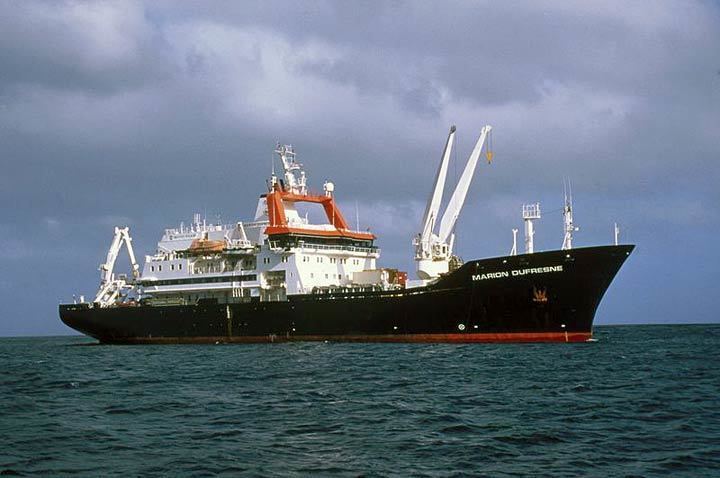 | ||
Namesake Marc-Joseph Marion du Fresne Owner CMA CGM The French Line Operator Institut polaire français Paul-Émile Victor (IPEV) for oceanography; Territory of the French Southern and Antarctic Lands (TAAF) for logistics Builder Ateliers et Chantiers du Havre | ||
The Marion Dufresne II is a research and supply vessel named in honor of 18th century French explorer Marc-Joseph Marion du Fresne launched in 1995 and having two main missions: logistic support for the French Austral Islands and oceanographic research.
Contents
- Mission
- Ship facilities
- Propulsion
- Boats
- Aircraft
- Heavy lifting
- Navigation
- Environment
- Information technology communication
- Science
- Facilities
- Geophysics
- Coring
- Integrated rear heavy sampling SIAM
- Eco tourism
- Notable events
- References
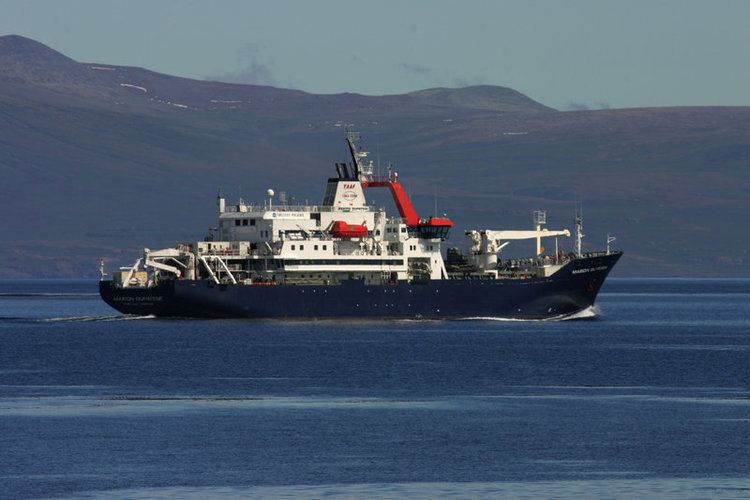
The Marion Dufresne II (IMO 9050814) is chartered by the French TAAF on an annual basis from the French shipping line CMA CGM (The French Line) and is maintained by the IPEV (Institut polaire français - Paul-Émile Victor). The current Marion Dufresne II is the replacement for slightly smaller Marion Dufresne I that served the TAAF from 1973 to 1995.
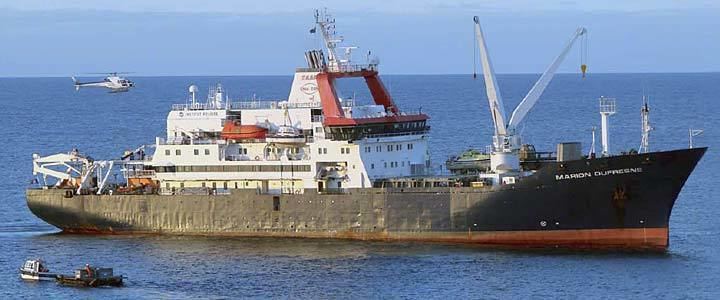
The ship was constructed by Ateliers et Chantiers du Havre of Normandy, France and delivered on 12 May 1995; it is registered out of the port of Marseille but its base of operations is the island of La Réunion.

The Marion Dufresne was designed for the very severe weather conditions of the Southern Ocean. She possesses exceptional seakeeping behavior — allowing full performance in the very rough seas found there.
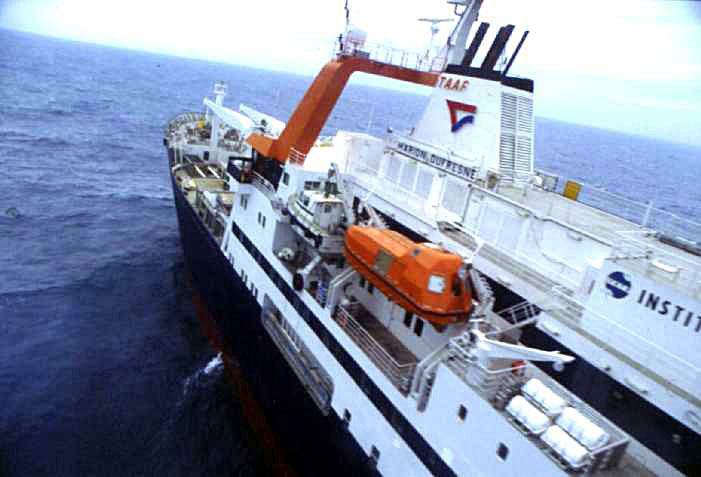
Mission

The Marion Dufresne is used to service the districts of the Crozet and Kerguelen Islands, and the smaller islands of Amsterdam and St-Paul, delivering supplies, fuel, and personnel to the three permanently manned bases there: Alfred Faure (Port Alfred), Port-aux-Français, and Martin-de-Viviès.
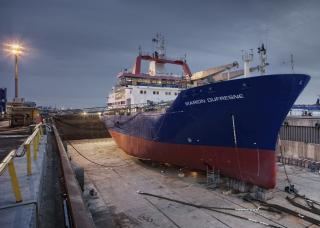
With the additional capacity as a logistics vessel, the Marion Dufresne, as a research vessel, is among the largest of the world fleet. Her accommodation options, freight handling, and endurance allow cruises and research campaigns of the most demanding sort.
Due to an increasing scientific demand, in 1999 the French Ministry of Research reduced the ship time devoted to logistical operations to 120 days per year and allowed the IPEV to conduct research world-wide for the remaining 245 days a year. Therefore, the ship is no longer confined to the Indian Ocean and conducts research in all oceans. This has allowed for the development of integrated, multidisciplinary programs, for instance, spending several months in 1999 coring for paleo-climatic purposes in the North Atlantic.
Ship facilities
With a capacity for 110 passengers in 59 cabins, the Marion Dufresne allows large scientific parties to embark on multidisciplinary programs. There is a hospital with operating theatre; pharmacy, video/conference center; library; gym and a ship's store.
Propulsion
Diesel-Electric propulsion is provided by three Cegelec electric motors – one 750 kW bow thruster and two AC synchronous electric propulsion motors: 2,650 kW ea manufactured by GEC Alsthom Moteurs driving two propeller shafts. Electric power to run the motors is generated by two 8-cylinder (8R32D) and one 6-cylinder (6R32D) diesel engines, manufactured by the Finnish company Wärtsilä.
Boats
The ship carries a complement of several smaller working boats on board. The largest is the container barge Gros Ventre ("Fat Belly"); others include a small utility boat, a semi-rigid rubber raft, and a zodiac. Naturally the vessel also carries the required types of life boats.
Aircraft
The Marion Dufresne possesses a helicopter platform and may carry one of a series of helicopters to ferry provisions and personnel from ship to shore. These may include the Eurocopter AS365 Dauphin, Eurocopter AS 350 Écureuil, and Aérospatiale Alouette II or III. These aircraft are leased from HeliLagon on Réunion.
Heavy lifting
The vessel possesses two fast 25-ton cranes (45 tons when coupled), one logistic/ oceanographic 18-ton crane, and one 3-ton service crane.
Navigation
The ship's complement of navigation equipment includes:
Environment
The ship's systems include:
Information technology & communication
The vessel has a broad array of communication and computing technologies including:
Science
Featuring modern facilities, it is operational in all fields of oceanography: marine geosciences, marine biology, oceanography, and the physics and chemistry of the oceans.
Facilities
There are 31 laboratories with 650m² (6,997 sq. ft.) total surface area, plus the possibility of additional lab containers on the bridges and helicopter platform.
Geophysics
The vessel possesses a full suite of geophysical equipment including multi-beam bathymetry and imagery and includes:
Coring
The Marion Dufresne with its giant corer Calypso, is one of the few ships to collect sediment cores up to 60 metres (200 ft) in length. Calypso is a Kullenberg type round piston corer adjustable 2 to 12-tonnes (2.2 - 13.2 tons) and 70 m (230 ft) long. There is also on board, the CASQ square gravity corer (25x25cm x12m long). Since 1995, a program involving 26 nations aims to collect and interpret paleoclimatic data from cores taken in all the world's oceans.
Integrated rear heavy sampling (SIAM)
Over the stern sampling equipment includes:
Eco-tourism
In addition to the usual complement of scientists, researchers, technicians and construction workers, in recent years the Marion Dufresne has also played host to an increasing number of tourists (up to 14 per trip) who book passage for a period lasting about 28 days. A 9,000-km (5,590 mi.) passage includes guided tours of Crozet, Kerguelen, and Amsterdam Islands – with opportunities to view the local wildlife. The ship's cabin appointments are simple but comfortable, and several forms of entertainment and exercise are available on board. Meals served on board are considered to be of excellent quality; the dining room can seat up to 58 at a time in two seatings.
Notable events
On 15 December 2008, the ship was involved in the rescue of Bernard Stamm, whose IMOCA Open 60 racing yacht Cheminées Poujoulat ran aground and sustained significant hull damage near the Kerguelen Islands during the 2008-2009 edition of the Vendée Globe round the world, single hand yacht race.
On 14 November 2012, Marion Dufresne ran aground as she reached Crozet Islands as part of third resupply campaign of the year. The incident resulted in a 25-metre breach in the hull, flooding of two watertight compartments, and disabling of the bow thruster. The crew managed to control the damages and safely returned the vessel off the island. The 110 passengers were evacuated by the on-board helicopter to the small station located on the island. After being assessed for seaworthiness, repairs were effected at the Elgin Brown & Hamer shipyard in Durban, South Africa. A similar accident occurred in 2005.
